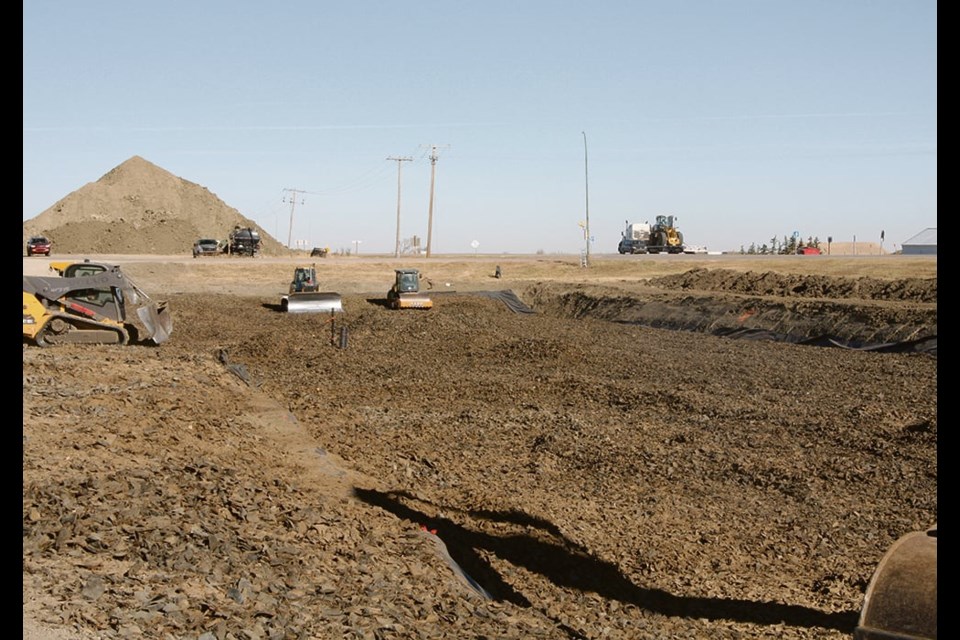CORINNE, Sask. — A farmer south of Regina still has many questions after the provincial highways’ ministry expanded a dugout on his property and filled it with shredded tires.
John Metz, who farms in the Wilcox area, said he knew the ministry wanted to expropriate land for the eventual twinning of Highway 6 but not that the plan included dumping 12,000 cubic metres of tire derived aggregate into a pit about 60 metres from a house.
A highways spokesperson said this is a pilot project to use the TDA, as it’s called, as fill during site preparation because the same volume is lighter than dirt and it can cushion vibration.
But Metz, a retired Moose Jaw police officer, wonders why the government can bury tires when they aren’t supposed to be landfilled.
“I’m beside myself,” he said last week as contractors prepared to cap the TDA. “Why can they do this 60 metres from my house?”
He isn’t even sure if the house and outbuildings will remain standing once the twinning begins and said he has had little information from the government since learning in 2019 of the intention to expropriate.
John and Teri Metz own 4.7 acres in the community of Corinne along the highway and, although it’s not their primary residence, they use the farmhouse during busy farming seasons. The Canadian Pacific Railway also runs along the edge of the property.
Metz said in 2019 they learned the highways ministry was considering several concepts for the twinning project and received a notice that some objects on the property, including an antique tractor and wagon, were impeding sightlines.
A property assessment didn’t happen until February 2021 and the results were not shared with the Metzes.
In June 2021 highways officials attended a rural municipality of Caledonia council meeting and said the Metzes had been fully consulted and were completely on side with the project, according to Metz.
When he called the ministry about this, he was again told the project was only at the concept stage.
Metz is a councillor in the Rural Municipality of Bratt’s Lake and when highways attended a meeting there and made the same claim, he said he was dumbfounded.
It was only when he found a surveyor on his property earlier this year that he realized a decision had been made without consulting him. He said he found out by accident that the highways department planned to fill the dugout with TDA.
“Nobody from the ministry of environment or ministry of highways contacted me,” said Metz.
The two parties also disagree over the value of his property. Metz valued the entire farmstead at $360,000 including the buildings and said he doesn’t know how the construction of another lane of highway will affect those buildings considering their proximity to it.
“I don’t know if I’m going to lose my house,” he said.
Highways offered $28,518.30 for the land, proximity and disruption of doing the work on the former dugout and the 2021 appraisal was $220,000 for the entire property.
“I agreed to mediation for compensation, but that’s before they’re doing all this digging,” he said.
Highways spokesperson Doug Wakabayashi said there is a well-established legal process for land acquisition. If the parties can’t agree on fair market value, the land is expropriated.
“What that means is we receive title to the land and what we do is we give payment to the landowner, usually it’s around 70 percent of what our final offer was, until we get the final survey completed,” he said.
The landowner then has two years to accept the offer or use the court process. Mediation and negotiation can continue during this time, but if a case does go all the way to court a judge will determine the fair market value.
A few weeks ago, contractors arrived at the site, pumped out the water in the 120-feet by 60-feet dugout and expanded it to 400 feet by 150 feet and 15 feet deep.
They hauled in the TDA from a stockpile owned by Tire Stewardship of Saskatchewan and prepared to cap it with clay.
The Metzes have asked for environmental data about the TDA and say they are worried about spontaneous combustion and other possible effects such as leaching.
Wakabayashi said TDA is considered safe.
The ministry of environment approved its use in roadway embankments in July 2021 and it has been used in other jurisdictions including Alberta, Manitoba and Ontario, he said.
According to information from Stantec, the company that designed the project, TDA benefits the environment by reusing the tires.
“These shreds are made of tires that cannot be recycled into value-added products,” said Stantec in an email provided by Metz. “If not used they would be stockpiled or landfilled; instead, they are being used in a useful way in road construction.”
The company said TDA will insulate the road and prevent it from freezing.
It also said the TDA had been stockpiled for three years without any concerns and that while exposed TDA could be prone to combustion “the Highway 6 layer has been designed and will be constructed to minimize a heating reaction.”
Wakabayashi said the highways ministry is twinning two sections of Highway 6 south of Regina, with construction likely to begin in 2023.
The first section is about 7.5 kilometres long and will start where the current twinning ends. The next section will be through the two junctions of Highways 6 and 39.
The new lanes in the second section will be built on top of where the Metz dugout used to be, and the TDA needs time to settle, he said.
Although he couldn’t comment on the safety of burying the material, he did say it isn’t the same as throwing tires into a pit because they have been shredded to a uniform size and steel and other waste removed.
“It’s considered to be an inert material. There’s no risk of leaching into ground water and things like that as well,” he said.

